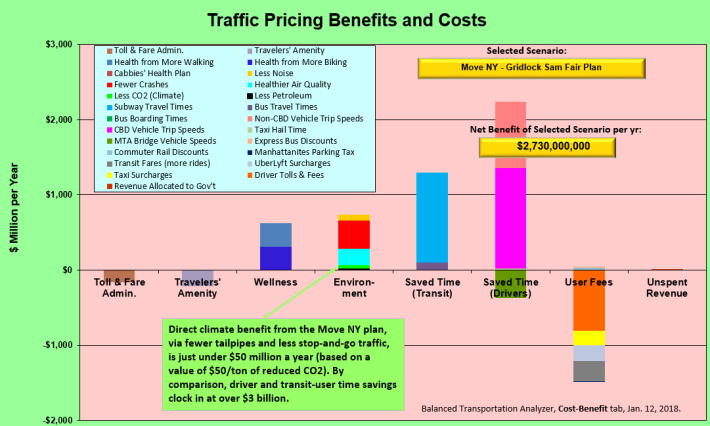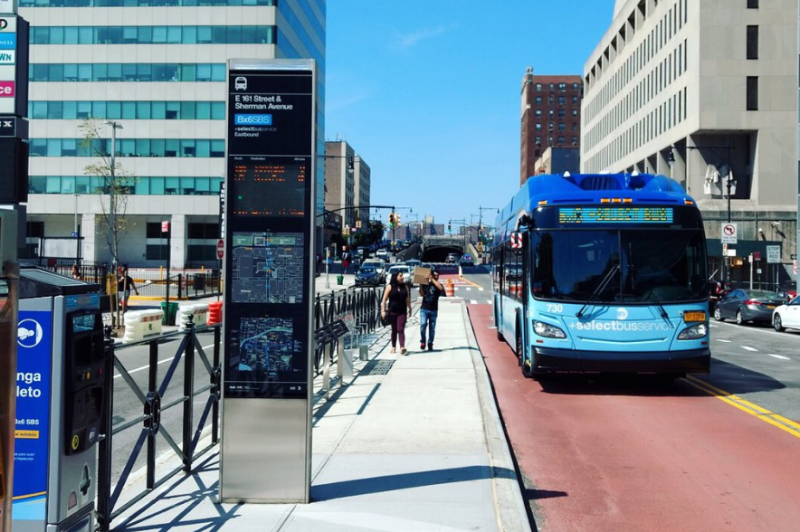Will congestion pricing deter climate change? I ponder that a lot, both as an ordinary citizen and as founder-director of the Carbon Tax Center, which promotes robust carbon taxes as a central policy for eliminating fossil fuels. My answer is: Yes -- though perhaps not in the ways you might think.
The most sweeping congestion pricing plan proposed for New York City, Move NY, will cut tailpipe emissions of carbon dioxide, the main greenhouse gas, by an estimated 950,000 metric tons a year. A little over half of that reduction, 55 percent, results from fewer auto trips from the toll disincentive along with transit improvements funded by toll revenues. The remaining 45 percent comes from smoothed traffic flow, as the lessening in stop-and-go traffic translates into better fuel economy and, thus, lower per-mile emissions. (Figures are from my downloadable BTA spreadsheet model.)
Official city data peg total NYC emissions of CO2 at 50 million metric tons a year, of which 15 million are from “on-road transportation” (motor vehicles). Move NY will shave just 2 percent from the total and 6 percent from the transportation part -- reductions somewhere between “modest” and “helpful,” and well short of game-changing.
That outcome neither surprises nor disturbs me. Congestion pricing, whether Move NY’s version or some other form, purposely addresses only one segment of New York City car and truck journeys -- those that involve the Manhattan central business district. And rather than doing away with those trips, it seeks to leave most of them intact to be tolled for revenue -- “billing, not banning driving,” you could say.
Because of this, Move NY will diminish citywide motor vehicle traffic by around 4 percent. That’s commensurate with the subset of city and area car trips that it targets -- those that, as a group, impose the greatest congestion costs, have the most robust transit alternatives, and are so valuable to their takers that most will continue to be made despite the toll, thus creating a hearty new revenue stream for transit.
What congestion pricing does fabulously well, then, isn’t to stop New Yorkers from driving but to make it easier for everyone to get around. I estimate the net time savings that residents and commuters will gain from the Move NY plan at 485,000 hours per day. Not only will traveling in and near the CBD be faster, it’ll be more reliable, less stressful, safer and healthier. An estimated 120,000 more people will come to the Manhattan core each day, as increased transit use, carpooling, cycling and walking more than offset the contraction in car trips from the new tolls.

In short, congestion charging will help New York function better. And therein lies its true climate payoff -- in the thousands of households, jobs, and activities that will locate or remain in the city, rather than fleeing our crushing gridlock and dysfunctional subways for the new exurban ring or the Sunbelt or even the inner suburbs, which aren’t “inherently green” like NYC and have carbon footprints many times larger than New Yorkers.
I haven’t tried to quantify that effect (surprise!), but the effect has got to be large. Consider that New York’s per capita CO2 emissions are two-thirds below the national average, according to city figures (6.1 metric tons per year vs. 19, or a difference of nearly 13 tons). If we credit each of those 120,000 additional travelers to the CBD with a CO2 saving of 13 tons compared to living or working in Anytown, USA, we arrive at an annual emission savings of over 1.5 million metric tons — far exceeding the 950,000-ton direct reduction from Move NY’s fewer and cleaner tailpipes.
While that calculation is strictly illustrative, it shows the upside. But the force multiplier from congestion pricing is bigger still. New York may not be the world’s biggest city, our subway system is no longer the largest, and we’re not the safest city despite our precipitous drops in violent crime. But our city remains the most iconic, the one that “inspires better than any other city in the world,” as meteorologist and Grist writer Eric Holthaus tweeted this week.
“What we need right now, more than anything,” Holthaus added, “is inspiration.” We need to show the citizens and leaders of the hundreds of other great cities around the globe how to turn congestion into revenues with which to build a city that’s sustainable, low-carbon, and humane.
With congestion pricing, New York City can fulfill writer-activist Bill McKibben’s vision of being “a capital of the fight against climate change."






